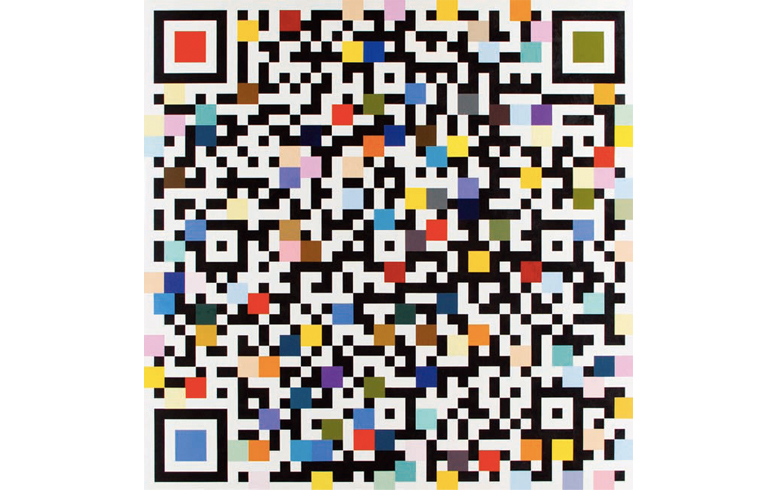BY SEA, LAND & AIR, WE PROSPER
| April 19, 2012 | Post In LEAP 13

Douglas Coupland wants to know what being alive means to you. What would you say to someone 100 years in the future, or 100 years in the past? His own answers are provided by his work in the group exhibition “By Sea, Land & Air, We Prosper” at Art Labor 2.0. This is Vancouver’s motto, and the city is the shared vein that unites the participating artists, who all call Vancouver home. Meanwhile, Vancouverite Ian Verchere, who now resides in Beijing, curated the show. Verchere and Coupland have known each other their entire lives: their mothers met in the smoking room of the maternity ward where they were both born. Vancouver is a young city, and there is a youthfulness that pervades “By Sea, Land & Air, We Prosper.”
Arabella Campbell’s pieces, near mirror images of each other, toy with place and space. A Catalogue of its own content is a series of eight acrylic-on-linen canvases of white rhombuses painted over a cardboard-colored background. Studies for an incomplete work is its scanned-and-printed counterpart. With both, the eyes are tricked: do the rhombuses lean into the negative space of the canvas, or are they formed by the very framing of that space? Where does the painting end, if at all? Is the shade of white here the same as that of the gallery wall?
The cheekiness continues with Brendan Tang’s Manga Ormolu series, which look like the expensive adult toys sold at Japanese boutiques in New York. Here, traditional Chinese pottery and its instantly recognizable blue-and-white palette get the contemporary treatment, as delicately painted ceramic is sleekly fused with bits of rubber and plastic. This collision of culture and material— East meets West, old meets new— is an examination of identity. “As the world becomes increasingly more interconnected,” he says, “I feel that my inquiry into identity, tradition, and culture are things [in which we] are participating.” If Tang’s ceramics are a mix of old and new, Douglas Coupland’s Memento Mori series— colorful, square, acrylic, and latex grid paintings— is unquestionably of the moment. At first glance, one might write them off as commentary on the death of interpersonal communication, or maybe even a critique of the extent to which technology controls our lives.
A computer on every desk, and in every home, God is Nowhere, God is now here, and the rest of the series are more than simple canvases: each is a fully functioning QR code, an optical barcode encoded with text, readable via electronic devices like smartphones. They literally speak to you: “You’re dead by now. You now know things I don’t. I wonder where you are, or if you are.” That Coupland would here focus on technology is not surprising: this is a man who was using the Internet pre-World Wide Web.
Epic Journey, one of video artist Kevin Schmidt’s three contributions to the show, is 11 hours and 30 minutes of parallel excursions, of men on a mission. In two aluminum boats, Schmidt and his crew took to British Columbia’s longest river for a night cruise; the artist himself is filmed alongside a running projection of The Lord of the Rings trilogy. It is the sort of meta film-within-a-film that will leave viewers familiar with video artists born in the 1970s unimpressed, but the tranquil lapping of the river allows one to get lost in the film.
The imported, sprightly enthusiasm of the exhibition culminates in Malaysian-born Germaine Koh’s SeeSawSeat, a “tool for social exchange” that compels gallery-goers to join one another in playing on a public bench-cum-teeter-totter. It is the sort of interactive art that sits well with a city like Shanghai, where the art scene could use a healthy dose of the facetious. Sophie Friedman

